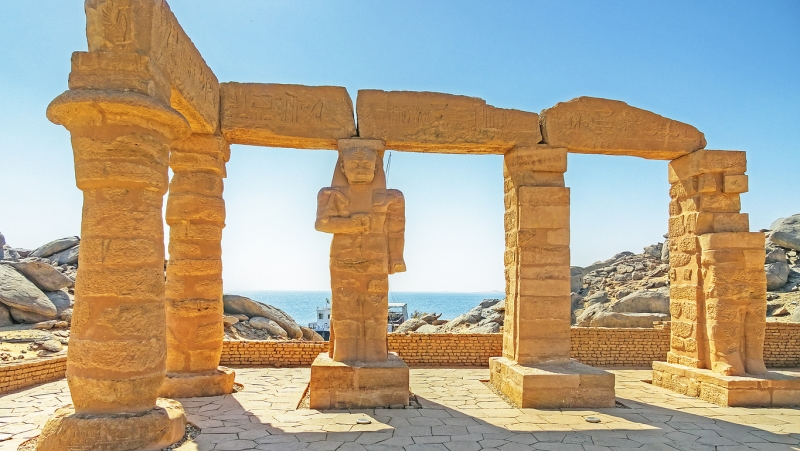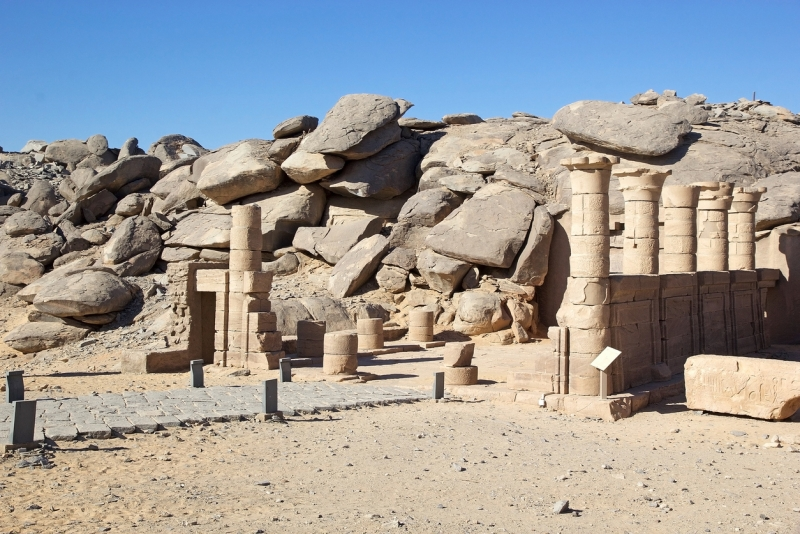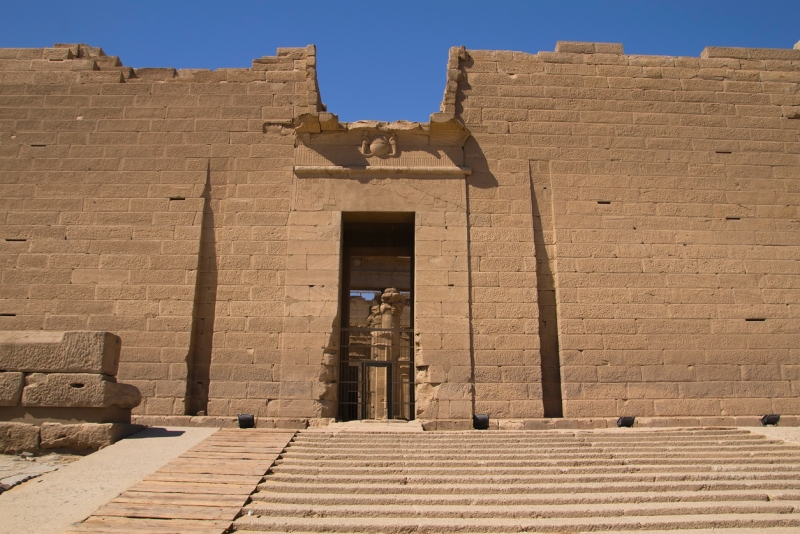Kalabsha Temple

Picture Egypt's most imposing free-standing temple, a colossal Nubian monument that somehow escapes the attention of countless visitors who flock to more famous sites. Kalabsha Temple commands attention through sheer scale alone—its original location at Bab al-Kalabsha, roughly 50 kilometers south of Aswan, housed a structure stretching 76 meters in length and 22 meters in width, displaying preservation quality that defies its millennia-old origins.
Emperor Augustus commissioned this architectural wonder around 30 BC during Rome's early dominion over Egypt, creating a sacred space devoted to Mandulis, the revered Nubian sun god, alongside other Egyptian deities. Yet Kalabsha's most captivating chapter unfolds not in antiquity, but in modern times. Engineers and archaeologists executed one of history's most ambitious rescue operations, methodically dissecting the entire temple into 13,000 precisely numbered blocks before reconstructing it stone by stone at its current lakeside location—all part of UNESCO's monumental effort to preserve Nubian treasures threatened by the rising waters of Lake Nasser. This extraordinary salvation story earned the temple its place on the UNESCO World Heritage List in 1979, cementing its status as both ancient masterpiece and modern miracle.
The Origins of Kalabsha Temple
Kalabsha Temple emerges from the early Roman period of Egypt as a remarkable fusion of architectural traditions and cultural influences, establishing itself among Nubia's most consequential religious monuments through centuries of continuous worship and expansion.
Built during the Roman era under Emperor Augustus
Rome's architectural ambitions in Egypt took concrete form around 30 BC when Emperor Augustus, fresh from establishing Roman dominion over the region, initiated construction of this monumental temple. Augustus, as Egypt's first Roman ruler, envisioned Kalabsha as a statement of imperial power melded with local religious traditions. Archaeological investigation reveals an intriguing detail: despite its grand conception, the temple remained perpetually unfinished throughout Augustus's reign.
Construction activity persisted through subsequent imperial dynasties, with Emperor Vespasian (69-79 AD) orchestrating significant architectural additions that expanded the temple's footprint and religious function. Stone inscriptions discovered within the temple chambers tell a story of enduring spiritual relevance—dated carvings span from Vespasian's era through approximately 248-249 AD, documenting nearly three centuries of active religious practice. These inscriptional records illuminate how Kalabsha maintained its sacred status long after its initial Roman founders had passed into history.
Dedicated to the Nubian sun god Mandulis
Mandulis—known alternatively as Merul—commanded primary veneration within Kalabsha's sacred precinct as the distinctly Nubian manifestation of solar divinity. Lower Nubian religious consciousness elevated this deity to extraordinary significance, typically portraying him as a human figure crowned with elaborate solar disk headdresses that proclaimed his mastery over celestial forces.
Religious practice at Kalabsha extended beyond Mandulis worship alone. Isis and Osiris claimed devotional space within the temple complex, creating a multifaceted spiritual center that accommodated diverse divine relationships. Historical documentation suggests Mandulis embodied dual aspects within Nubian belief systems—solar authority intertwined with fertility powers, reflecting the agricultural rhythms that governed Nubian life.
Constructed over an earlier sanctuary of Amenhotep II
Archaeological investigation beneath Kalabsha's Roman foundations reveals a much older sacred narrative. Excavations confirm that Roman builders erected their temple atop an existing sanctuary from Egypt's illustrious 18th dynasty. This earlier structure dates to Pharaoh Amenhotep II's reign around 1400 BC, establishing nearly fifteen centuries of continuous religious significance at this precise location.
Such architectural layering demonstrates how sacred geography transcends political transitions and cultural shifts. Roman architects demonstrated remarkable sensitivity to existing traditions, incorporating established Egyptian design principles while introducing their distinctive imperial flourishes. The result stands as a unique cultural bridge—a monument where ancient pharaonic spirituality merged seamlessly with Roman imperial ambitions, creating something entirely unprecedented in the ancient world.

Architectural Marvels of Kalabsha
Ancient engineering reaches extraordinary heights within Kalabsha's walls, where Egyptian tradition meets Roman innovation in a spectacular fusion of architectural mastery. These towering dimensions—76 meters stretching lengthwise and 22 meters spanning its width—establish it as Lower Nubia's most imposing free-standing temple.
The grand pylon and colonnaded court
A majestic stone causeway beckons visitors from Lake Nasser's shores toward the temple's first pylon. This colossal gateway soars approximately 14 meters skyward, its 9.70-meter entrance portal adorned with solar disk inscriptions and elaborate royal offering scenes. Architectural intrigue begins immediately—the pylon deliberately sits askew from the temple's central axis, crafting an unexpected trapezoid-shaped courtyard that challenges conventional temple design.
Step beyond this threshold to encounter a generous court encircled by colonnades spanning three sides. Each portico displays composite columns bearing sophisticated decorative elements. Twin staircases flank the courtyard's ends, ascending to the pylon's upper reaches where visitors glimpse the temple's masterful structural planning.
Intricate reliefs and hieroglyphs
Stone surfaces throughout Kalabsha reveal exquisite carvings depicting divine figures and ceremonial tableaux. These relief sculptures capture both Egyptian deities and Roman emperors engaged in worship, creating visual testimony to this era's cultural synthesis. Among the most remarkable examples stands a delicate carving of Horus emerging from papyrus reeds on the inner curtain wall.
Wall decorations within the hypostyle hall present sacrifice and worship scenes honoring Min, Chnu, and Mandulis. One column bears a particularly intriguing feature—a rare Meroitic inscription that continues to puzzle modern scholars.
The hypostyle hall and sanctuary chambers
Past the courtyard awaits the hypostyle hall, conceived with twelve supporting columns though only eight survive today. These remaining pillars showcase capitals adorned with elaborate floral designs, testament to the period's artistic sophistication.
The temple's sacred heart contains a three-chambered sanctuary, encompassing both the Hall of the Ennead and the Offering Hall. Here once stood Mandulis's divine statue, the focal point of centuries of worship.
Staircase to the rooftop and panoramic views
Hidden within one sanctuary chamber, a narrow staircase ascends to the temple roof, revealing breathtaking vistas across Lake Nasser, the towering High Dam, and endless desert expanses. This elevated vantage point offers both architectural appreciation of the temple's layout and spectacular photographic opportunities that draw modern explorers to this remarkable site.

The Great Relocation: Saving Kalabsha from the Nile
Archaeology rarely witnesses such dramatic race-against-time scenarios, yet Kalabsha Temple's survival story reads like a thrilling rescue operation where international cooperation triumphed over seemingly impossible odds. The temple that captivates visitors today owes its existence to one of the most ambitious cultural preservation projects ever undertaken.
Threat from the Aswan High Dam and Lake Nasser
Egypt's decision in 1954 to construct the Aswan High Dam represented a watershed moment for the nation's industrial future—and a death sentence for countless ancient treasures. This colossal engineering project, spanning construction years from 1960 to 1971, would birth Lake Nasser, an artificial sea stretching from Aswan deep into Sudan, swallowing the entire Upper Nile Valley beneath its waters. The mathematics were stark: Kalabsha Temple, along with dozens of other monuments, faced submersion under 50 meters of rising lake water. Time was running out for these irreplaceable witnesses to human civilization.
UNESCO's International Campaign to Save Nubian Monuments
Recognizing the cultural catastrophe looming over Nubia, Egyptian and Sudanese authorities issued an urgent appeal to UNESCO in 1959. The response was unprecedented—UNESCO's Director-General launched the International Campaign to Save the Monuments of Nubia the following year, mobilizing resources from across the globe. This extraordinary rescue mission excavated hundreds of archaeological sites, salvaged thousands of artifacts, and orchestrated the relocation of entire temples to safer ground. When the campaign concluded on March 10, 1980, UNESCO declared it "a complete and spectacular success," a testament to what international determination could achieve. Recognition followed swiftly—the saved monuments, spanning from Abu Simbel to Philae, earned UNESCO World Heritage status in 1979.
Germany's role and the gift of the Kalabsha Gate
West Germany emerged as an unlikely hero in Kalabsha's salvation story. German authorities volunteered early in the campaign to shoulder responsibility for dismantling and reconstructing the entire temple complex. This commitment wasn't random—Germany's deep Egyptological roots traced back to scholars like Franz Christian Gau, who had documented Kalabsha as early as 1819. Egypt's gratitude took tangible form in 1971 when officials gifted one of Kalabsha's gates to Germany. Since 1977, this ancient portal has graced Berlin's Egyptian Museum in Charlottenburg. Future plans envision its transfer to serve as the grand entrance to Berlin's Pergamon Museum's fourth wing.
Reconstruction at New Kalabsha near Aswan
The actual relocation unfolded with surgical precision over more than two years, each stone block carefully catalogued and transported. Today's visitors encounter the reconstructed temple on New Kalabsha Island, positioned 15 kilometers south of Aswan in the shadow of the High Dam. This island sanctuary now shelters multiple rescued Nubian treasures, including the Temple of Beit el-Wali, the Temple of Gerf Hussein, and the elegant Kiosk of Qertassi. The sheer scale defies imagination—twenty thousand tons of ancient stone found new homes during this preservation marathon, ensuring these cultural treasures would inspire future generations rather than rest forever beneath Lake Nasser's depths.

Customize Your Dream Vacation!
Get in touch with our local experts for an unforgettable journey.
Plan Your Trip
Planning Your Visit to Kalabsha Egypt
Reaching this remarkable monument requires strategic planning, but the reward far exceeds the effort involved. Few ancient sites offer such pristine access to Roman-era architecture without the typical tourist crowds found at Egypt's more celebrated destinations.
How to get there: boat, car, or tour
Several transportation routes lead to Kalabsha Temple, positioned roughly 16 kilometers from Aswan near the imposing Aswan High Dam on Lake Nasser's shores. Your options include:
- Maritime approach: Motorboats depart from the jetty adjacent to the High Dam, where local fishermen serve as skilled navigators of these waters. Expect negotiations to settle around 100-150 EGP for an hour-long exploration—a bargain considering the exclusive access to this archaeological gem.
- Overland journey: Taxi drivers from Aswan complete the 40-minute route for approximately 4.583 KWD. Budget-minded adventurers often combine microbuses with strategic hitchhiking, though this requires patience and local knowledge.
- Guided expeditions: Tour operators from Aswan offer structured visits ranging from 60-135 USD per participant, with pricing dependent on group composition and included amenities.
Best time to visit and weather tips
October through March presents ideal conditions, when Egypt's intense heat moderates to comfortable exploration temperatures. Dawn hours and late afternoon periods deliver superior photographic lighting while maintaining pleasant atmospheric conditions. Weekday visits typically ensure quieter encounters with this ancient marvel, allowing deeper appreciation of its architectural details.
What to wear and bring
Egypt's climate and cultural sensitivities dictate thoughtful preparation:
- Appropriate attire: Lightweight, loose garments covering shoulders and knees demonstrate proper respect while ensuring comfort. Sturdy walking footwear proves essential for navigating ancient stone surfaces.
- Essential equipment: High-SPF sunscreen, protective eyewear, wide-brimmed headwear, hydration supplies, and photographic equipment.
- Required documentation: Passport or certified copies, as security checkpoints operate throughout this sensitive border region.
Nearby attractions: Philae, Abu Simbel, Nubian Museum
Strategic itinerary planning can encompass multiple Nubian treasures:
Philae Temple: Another rescued monument accessible via boat transport.
Abu Simbel: Ramses II's colossal statuary commands attention at this relocated wonder.
Nubian Museum: This 1997 institution houses thousands of artifacts rescued from Lake Nasser's rising waters.
Lake Nasser cruise vessels provide access to multiple relocated monuments, creating efficient multi-site exploration opportunities for serious archaeology enthusiasts.
Photography and site etiquette
Photographic regulations vary across Egyptian archaeological sites. Some locations permit flash-free photography, while others maintain complete restrictions. Local guides on Egypt tours possess current regulation knowledge and should be consulted before equipment deployment.
Respectful behavior includes shoe removal where indicated, maintaining subdued conversation levels, and avoiding physical contact with ancient carvings or relief work. Supporting local communities through responsible tourism practices and proper waste management reflects well on all international visitors to this precious cultural site.
If you’re exploring temples in Egypt, Kalabsha stands out because it’s the largest free-standing temple in Lower Nubia. What makes it extra special is its Roman-era origins and its dramatic relocation story — it was moved block by block to save it from the rising waters of Lake Nasser after the construction of the Aswan High Dam.
Kalabsha Temple dates back to 30 BC during the reign of Emperor Augustus. When you visit, you’ll notice that it was dedicated to Mandulis, the Nubian sun god, but you’ll also find carvings honoring Isis, Osiris, and other deities, blending both Egyptian and Nubian traditions.
Reaching Kalabsha Temple is part of the adventure! From Aswan, you can take a boat ride across Lake Nasser from the jetty near the High Dam — a favorite choice for many travelers. You can also go by car or taxi (about 40 minutes) or join an organized tour from Aswan. The boat ride is especially popular for its scenic views and local charm.
Walking through Kalabsha, you’ll be struck by its impressive pylon with a 9.7-meter-high gateway, a colonnaded courtyard, and a hypostyle hall with decorated columns. Don’t miss the detailed hieroglyphs and reliefs carved into the walls. If you climb to the rooftop, you’ll be rewarded with panoramic views of Lake Nasser and the surrounding desert.
The best time to explore Kalabsha is between October and March, when Aswan’s weather is cooler and more comfortable. If you go in the early morning or late afternoon, you’ll not only avoid the midday heat but also catch the best lighting for photography. Weekdays are usually quieter, giving you more space to enjoy the temple at your own pace.







